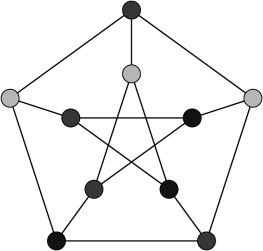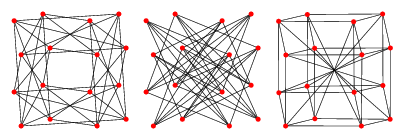Maximum weighted independent set - singletons and forest
Gus wants to open franchises of his restaurant, Los Pollos Hermanos, along Central Avenue. There are $n$ possible locations for franchises, where location i is at mile i on Central. Each location i > 1, is thus a distance of 1 mile from the previous one. There are two rules.
- At each location, there can be at most one restaurant, and the profit of a restaurant at location i is $p_i$.
- Any two restaurants must be at least 2 miles apart.
This is one way to state the sequential facility location problem, which can be solved efficiently using a memo-ized dynamic program:
int sequentialFacility(idx, profits[]):
if (idx >= profits.length)
return 0
return MAX( sequentialFacility(idx + 1), sequentialFacility(idx + 2) + profits\[idx\])
Its generalization, graph facility location, is NP-complete, being equivalent to finding the maximum weighted independent set of a graph. This post is about calculating the weight of such a set, and the number of ways to find this maximum weight, for a general graph. We’ll assume non-negative weights throughout.
Let’s start with graph representation. We’ll assume that the graph can be conveniently represented with BitSets (which are very efficient to work with). This graph can be searched with a map that gives the adjacent set for each node, and then node independence can be tested for quickly:
/*
* @return true iff the nodes in a given set are independent. Assumes that all BitSets involved are of the same
* size, and that a node is not adjacent to itself. O(n^2) really, but still much faster
*/
private static boolean isIndependent(BitSet set, Map<Integer, BitSet> adjacent) {
for (int i = set.length(); (i = set.previousSetBit(i - 1)) >= 0;) {
if (set.intersects(adjacent.get(i))) {
return false;
}
}
return true;
}
Singletons
What if the given graph is composed only of singletons? The max weight of the independent set is trivial: sum of all nodes. The number of ways to achieve this max depends on whether or not there are nodes with zero weight. There are three cases:
- All node weights are positive
- All node weight are zero
- Non-negative weights
(1) is trivial, and there is only 1 way to achieve the max weight; (2) implies a power-set: there are $2^n$ ways to sum to 0 using only 0s, including the null set; (3) implies a union of (1) and (2) - there are $2^k$ ways, where $k < n$ is the number of nodes with zero weight.
/* * For N singletons, each with weight w[i] >= 0, returns the sum of weights, and the number of ways to achieve
* sum-weight, across singletons. For all non-zero components, there's only one way to achieve sum-weight.
*/
private static Result singletons(int[] w) {
int zeros = 0, sum = 0;
for (int i = 0; i < w.length; ++i) {
if (w[i] == 0) {
++zeros;
}
sum += w[i];
}
// zeros translates to power-set (including the null set)
if (zeros == w.length) {
return new Result(0, BigInteger.valueOf(2).pow(w.length));
} else if (zeros == 0) {
return new Result(sum, 1);
}
// size of the union of non-zeros (treated as one set) and the powerset of zeros i.e. null set is accounted for
return new Result(sum, BigInteger.valueOf(2).pow(zeros));
}
Forest
Though a forest in graph theory refers to a disjoint set of trees, we’ll use it to mean any disjoint set of connected components. Forests are a natural extension of singletons, and help decompose a given graph into smaller independent set problems. If we are given all the connected components of a graph, and, for each component, the sum of its weighted max independent set and the number of ways to find the sum; how can we combine this information to solve for the general graph? We face the same three cases:
- All component weights are positive: the graph sum is the sum of all components, and the number of ways is the product of the ways of all components.
- Zero weights: perhaps the most interesting case. Consider three components with ways (1, 2, 3). The number of ways of combining them would be: 1 + (1 + 2 + 3) + (1*2 + 2*3 + 1*3 )+ (1*2*3). This enumeration forms a pretty polynomial: given values a, b, c…, there are (a + 1)(b + 1)(c + 1)… ways (including null set). This generalizes naturally to the power-set for the case where a = b = c …= 1.
- As before, it’s a union of (1) and (2)
/*
* For N components, each with weight w[i] >= 0, returns the sum of weights, and the number of ways to achieve
* sum-weight, across components. For all non-zero components with ways = 1, there's only one way to achieve
* sum-weight. For zeros, well, it's a little more complicated. E.g. given components with 0 max, and ways (a, b, * c), there're 2^3 combinations of combinations: a + b + c + (a * b) + (a * c) + (b * c) + (a * b * c) = (a + 1)(b * + 1)(c + 1) e.g. 1 + 2 + 3 + 1*2 + 2*3 + 1*3 + 1*2*3 + 1 (including null set)
*/
private static Result components(Result[] c) {
int zeros = 0, sum = 0;
BigInteger nonzeroProduct = BigInteger.ONE;
for (int i = 0; i < c.length; ++i) {
if (c[i].max == 0) {
++zeros;
} else {
nonzeroProduct = nonzeroProduct.multiply(c[i].ways);
}
sum += c[i].max;
}
// all components have non-zero max
if (zeros == 0) {
return new Result(sum, nonzeroProduct);
}
// since we already have the number of ways to sum all non-zero components,
// find the number of way to sum zero components by evaluating the product polynomial
BigInteger zeroTotal = BigInteger.ONE;
for (int i = 0; i < c.length; ++i) {
if (c[i].max == 0) {
BigInteger ways = c[i].ways;
zeroTotal = zeroTotal.multiply(ways.add(BigInteger.ONE));
}
}
if (zeros == c.length) {
return new Result(sum, zeroTotal);
}
// now the total number is nonzeroProduct * (zeroTotal) since non-zero components together form a valid
// combination without any zero components involved.
return new Result(sum, nonzeroProduct.multiply(zeroTotal));
}
Once we’ve accounted for singletons and forest, we need to solve the independent set problem for each connected component. This would the topic of the next post.


